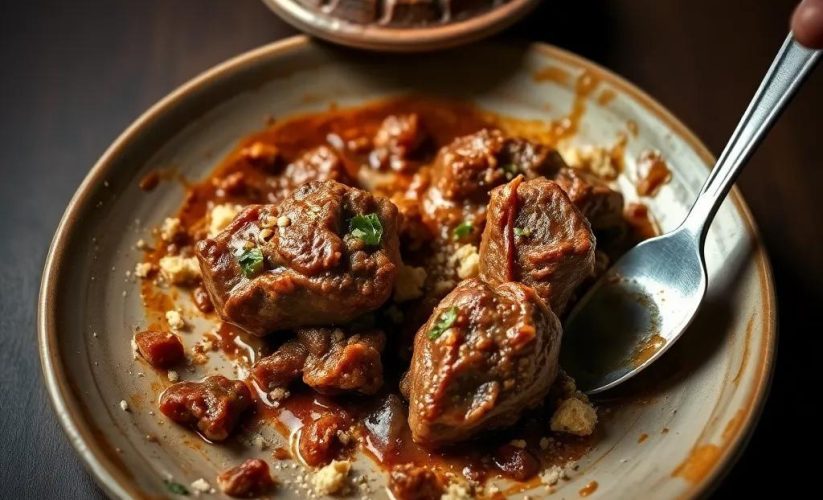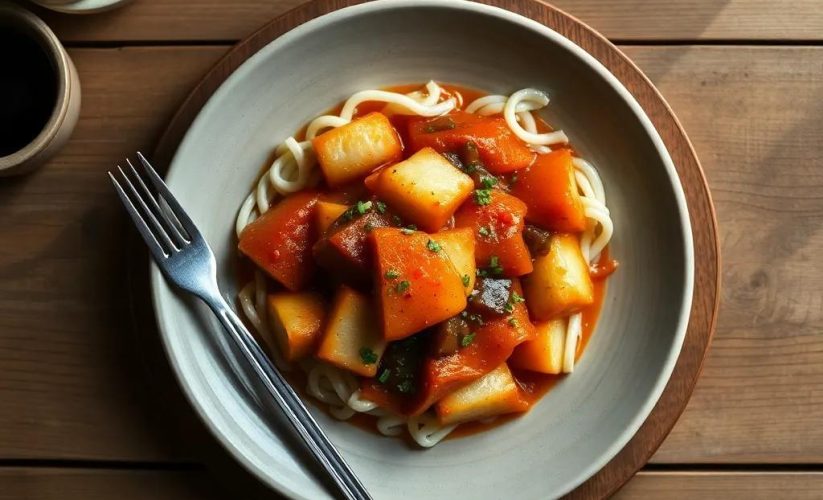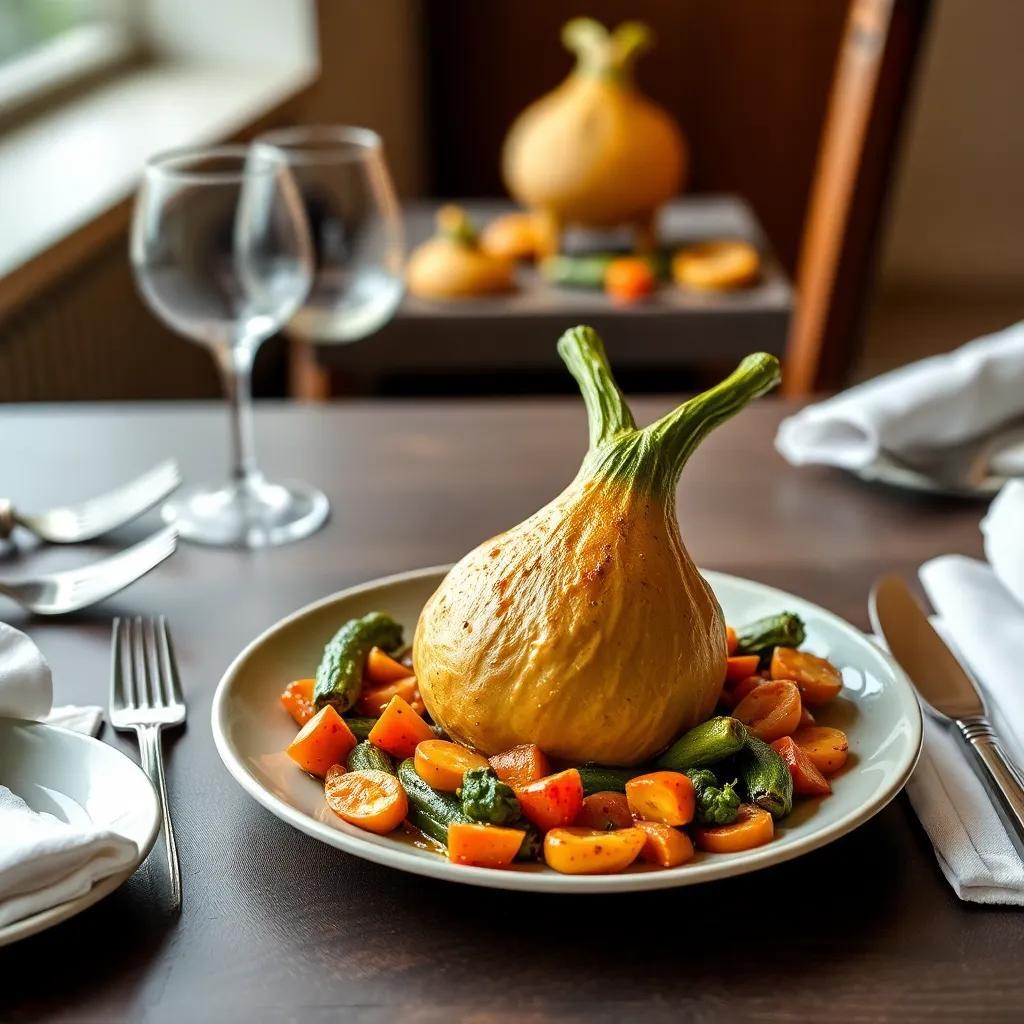Classic Coq au Vin Recipe: Rich, Hearty French Comfort Dish
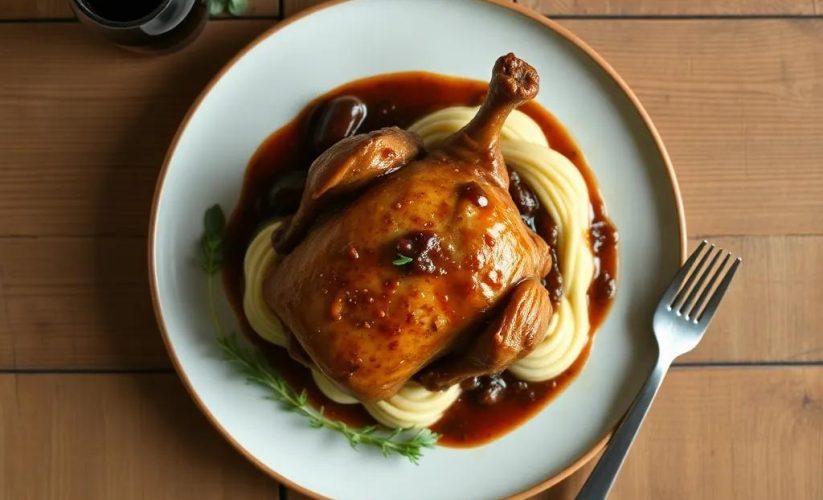
Classic Coq au Vin Recipe: Rich, Hearty French Comfort Dish
🌍 Cuisine: French
⚙️ Difficulty: Medium
Ingredients
Nutrition Facts
480 kcal
Instructions
- Pat the chicken pieces dry with paper towels and season generously with salt and pepper.
- In a large heavy-bottomed pot or Dutch oven, cook the diced bacon over medium heat until crisp. Remove bacon with a slotted spoon and set aside, leaving the fat in the pot.
- Add the chicken pieces to the pot and brown on all sides over medium-high heat, about 8-10 minutes. Remove chicken and set aside.
- Add the pearl onions and mushrooms to the pot with butter and olive oil. Sauté until the onions begin to caramelize and mushrooms are browned, about 8 minutes.
- Stir in the garlic and cook for 1 minute until fragrant.
- Sprinkle the flour over the vegetables and stir continuously for 2-3 minutes to cook out the raw flour taste and create a roux.
- Slowly pour in the red wine and chicken broth while stirring to avoid lumps.
- Add the tomato paste, bay leaves, thyme sprigs, reserved bacon, and browned chicken pieces back into the pot. Stir to combine.
- Bring the mixture to a boil, then reduce heat to low, cover partially, and simmer gently for 1.5 to 2 hours, or until the chicken is tender and cooked through.
- Remove bay leaves and thyme sprigs. Taste and adjust seasoning with salt and pepper as needed.
- For a thicker sauce, uncover and simmer for an additional 10-15 minutes to reduce.
- Garnish with freshly chopped parsley before serving.
- Serve hot with crusty French bread, mashed potatoes, or buttered noodles.
Serving Suggestions
- Serve Coq au Vin with creamy mashed potatoes to soak up the rich sauce.
- Accompany with buttered egg noodles or wide pasta ribbons.
- Pair with a simple green salad dressed with vinaigrette for freshness.
- Offer crusty French baguette or rustic country bread for dipping.
- Complement with a glass of the same red wine used in cooking.
- Steam some green beans or roasted root vegetables as a side.
- Top with extra chopped fresh parsley or chives for a burst of color and freshness.
Table of Contents
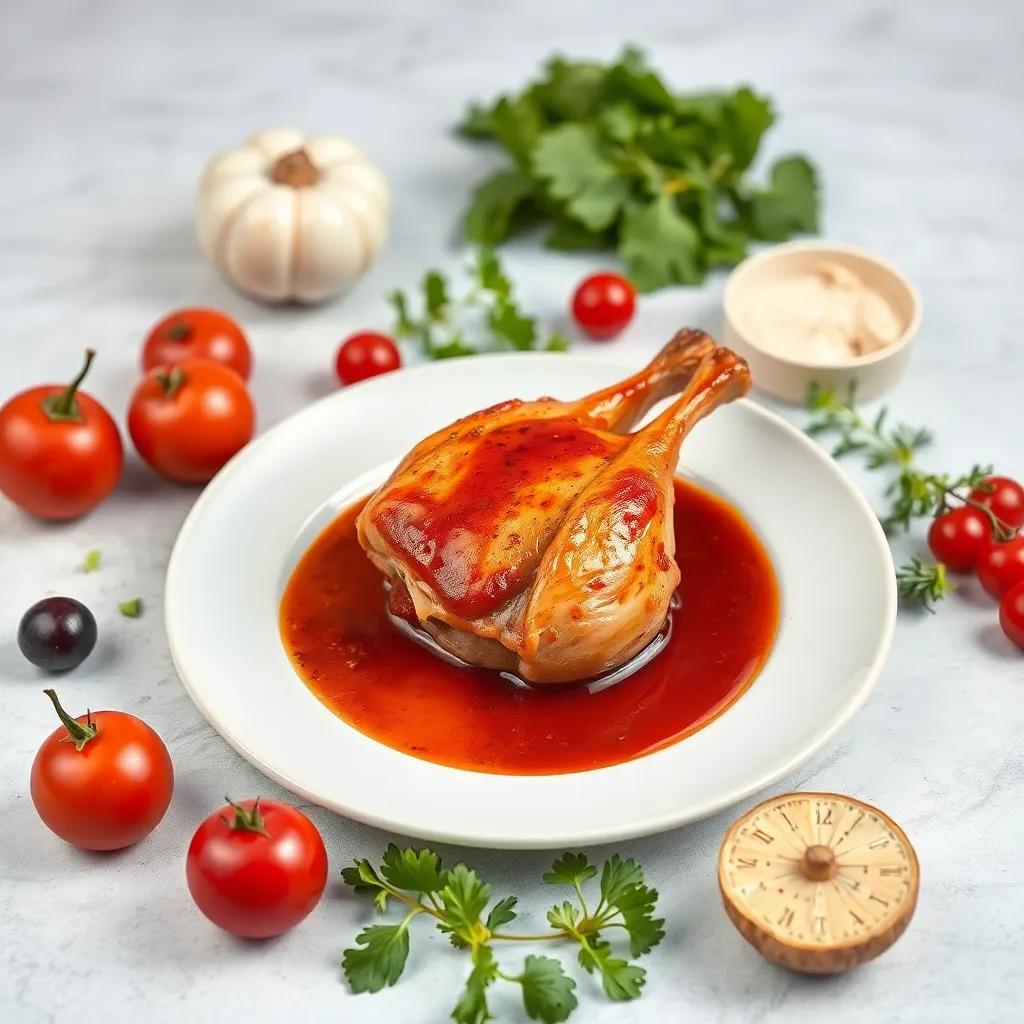
Intro
Coq au Vin is more than just a meal—it’s an invitation to slow down, savor, and celebrate the art of traditional French cooking. This classic dish embodies a perfect harmony of rich flavors and comforting textures, making it a beloved staple for family dinners, special gatherings, or cozy weekend indulgences. While it takes a bit of time and attention, the process is far from complicated; rather, it’s a rewarding culinary journey that transforms simple ingredients into a deeply satisfying feast.
What makes Coq au Vin truly exciting to make is how it effortlessly showcases the magic that happens when quality wine, tender chicken, and a bouquet of herbs slowly meld together. Its hearty sauce, enriched with bacon and mushrooms, wraps each bite in a luscious embrace that’s both luxurious and homey. Whether you’re unwinding after a busy day or entertaining friends who appreciate a meal with soul, this dish fits beautifully on the table, paired with rustic bread or creamy sides to sop up every last drop of sauce.
Ideal for cooler weather or any occasion when you crave a comforting, fuss-free yet impressive dinner, this recipe invites you to engage in the timeless tradition of cooking with patience and passion—promising a rewarding payoff that lingers well beyond the last bite.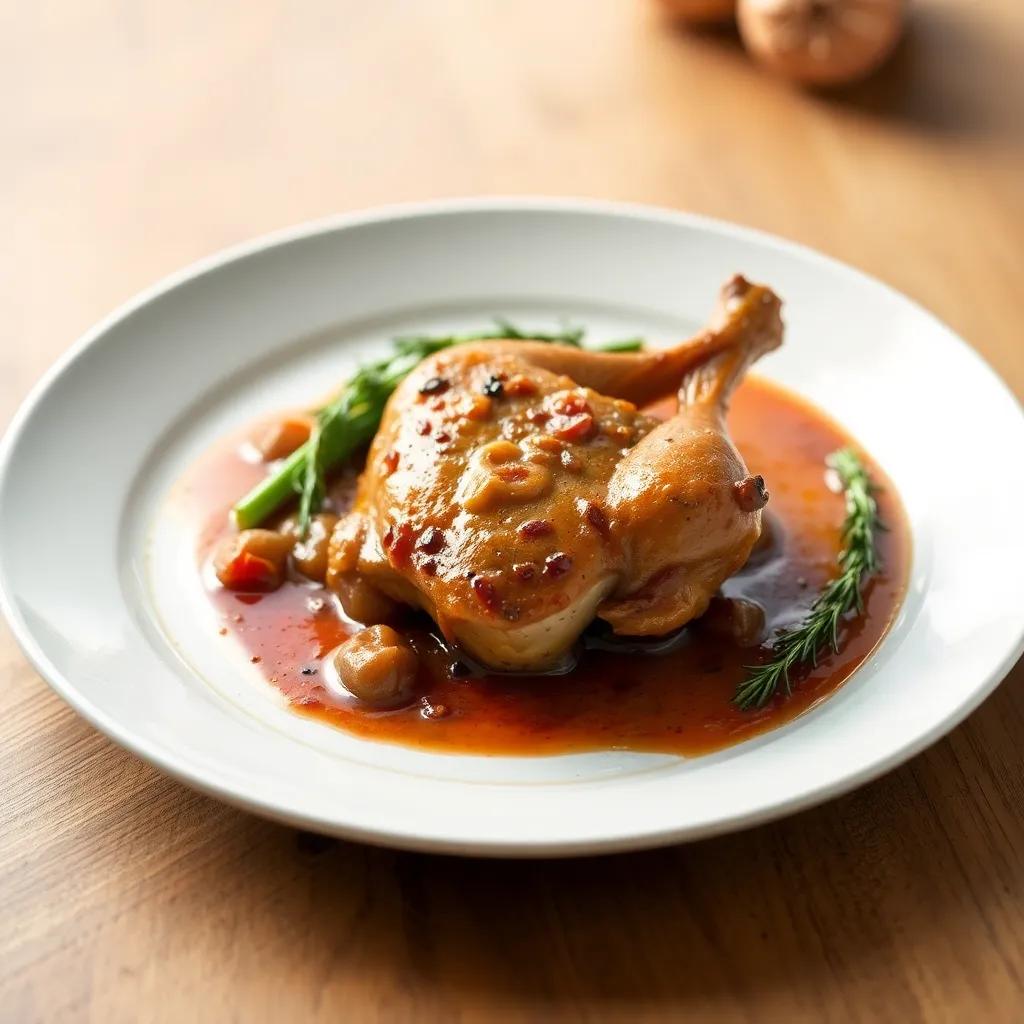
Ingredient Notes
A few key ingredients truly define the soulful character of Classic Coq au Vin, elevating it from a simple chicken stew to a truly memorable dish. Understanding these elements and choosing them wisely can make all the difference in your final result.
Red Wine (Burgundy or Pinot Noir):
The wine is the heart and soul of Coq au Vin, providing depth, acidity, and rich fruitiness that permeate every layer of flavor. Burgundy, with its balanced earthiness and bright red berry notes, is traditionally favored. Pinot Noir offers a lighter style that still lends complexity without overpowering the chicken. When selecting your wine, avoid inexpensive, overly tannic varieties that can introduce bitterness; instead, opt for a reasonably good bottle that you would enjoy drinking. If wine is unavailable, a quality grape juice mixed with a splash of vinegar can be a last-resort substitute, though it won’t replicate the authentic taste.
Bacon or Pancetta:
This smoky, savory morsel infuses the dish with umami and a slightly crispy texture that complements tender chicken. Pancetta, Italy’s version of cured pork belly, is an excellent alternative to bacon if you want a milder, more delicate smoky flavor without overpowering saltiness. When shopping, look for cuts with a good balance of meat and fat—too lean and you might lose depth, too fatty and it could make the sauce greasy. Rendering the bacon slowly at the start helps create a flavor-rich fat base for browning the chicken and sautéing vegetables.
Pearl Onions:
These petite onions add subtle sweetness and a tender bite that contrasts beautifully with the savory sauce. Their natural sugars caramelize as they cook, lending a gentle complexity that standard yellow onions can’t quite mimic. If fresh pearl onions are hard to find, frozen versions work well and save prep time, though be sure to thaw and drain them first to prevent excess moisture in the stew. Alternatively, shallots can be used for a similar mild, sweet onion flavor.
Fresh Herbs (Thyme and Bay Leaves):
Fresh thyme sprigs and bay leaves impart fragrant, woodsy notes that linger throughout the slow-simmered sauce. The herb bouquet is essential in creating Coq au Vin’s signature aromatic profile. When possible, choose fresh herbs over dried for brighter flavor. If fresh are unavailable, use a smaller amount of dried thyme and a bay leaf—but remember to remove the bay leaf before serving, as its texture can be tough. For an added layer, a few stems of parsley stirred in at the end provide a fresh, green lift to the richly sauced dish.
By prioritizing quality and understanding the role of these ingredients, you’ll set the stage for a Coq au Vin that’s as authentic and rewarding as the classic French original.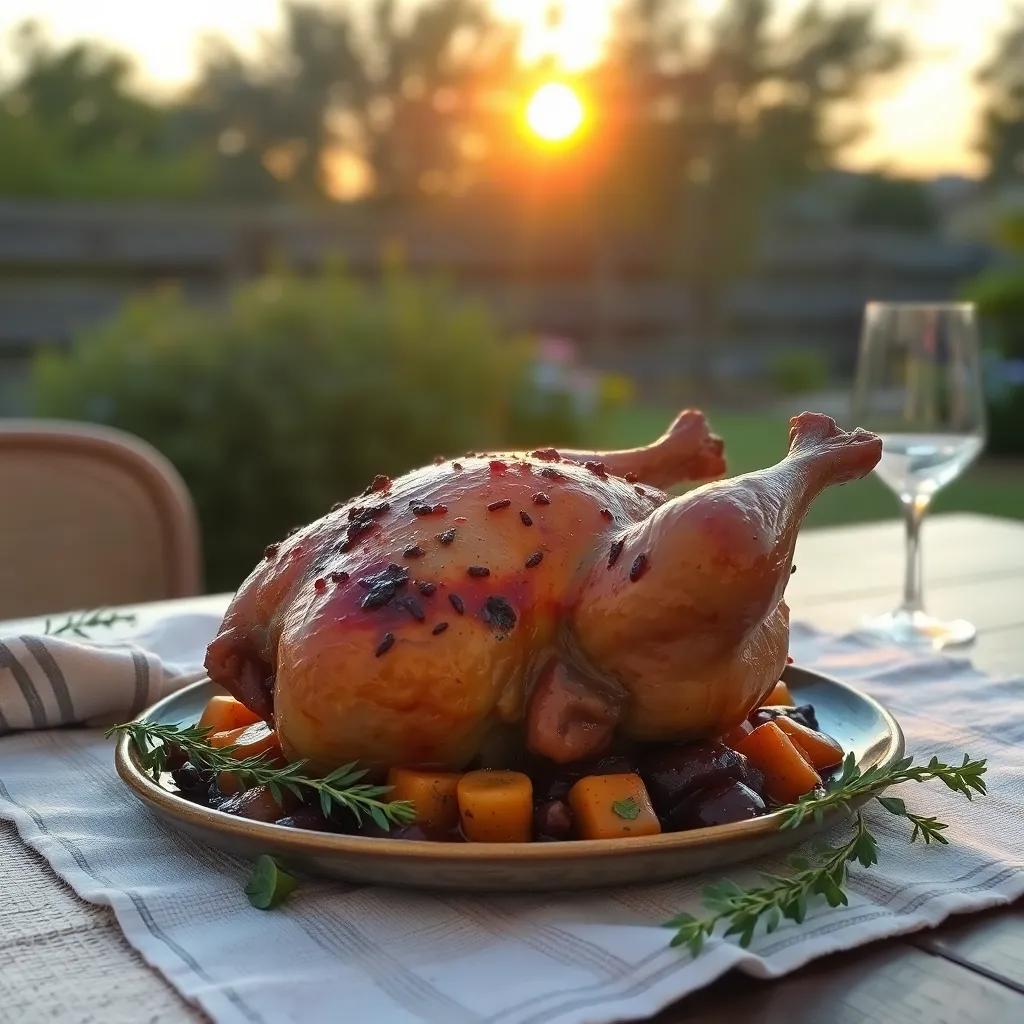
Tips & Variations
To achieve the richest depth of flavor and the perfect texture in your Coq au Vin, here are some expert tips and thoughtful variations to guide your cooking adventure:
- Brown the Chicken Thoroughly: Don’t rush the browning step. Searing the chicken pieces until golden not only adds color but creates complex caramelized flavors through the Maillard reaction. Use medium-high heat, and work in batches if needed to avoid crowding the pan, which can cause steaming rather than browning.
- Deglaze with Purpose: After browning, the fond (the browned bits stuck to the pot) holds intense flavor. When you pour in the wine and broth, gently scrape the bottom to dissolve those bits into the sauce, building layers of taste that elevate the dish beyond a simple stew.
- Patience is Your Best Ingredient: The slow simmering allows the chicken to become melt-in-your-mouth tender and the sauce to thicken, concentrate, and marry its elements beautifully. Resist lifting the lid too often, which lets steam escape and can slow cooking.
- Customize Your Mushrooms: While cremini or button mushrooms are classic, feel free to experiment with shiitake, porcini, or even chanterelles for an earthy twist. Just ensure they are sliced uniformly for even cooking.
- Adjust Wine Choices to Mood & Occasion: While traditionalists favor Burgundy, a Beaujolais or even a sturdy Merlot bring different nuances. For a more rustic vibe, try a Côtes du Rhône. If wine isn’t an option, a rich mushroom or vegetable broth plus a splash of balsamic vinegar can mimic some acidity and depth.
- Gluten-Free Adaptation: Swap the all-purpose flour for cornstarch or arrowroot powder to thicken the sauce. Stir in a slurry toward the end of cooking rather than making a traditional roux, to avoid clumping. This keeps the dish friendly for gluten-sensitive diners without sacrificing silkiness.
- Make It Vegan or Vegetarian: Replace chicken with hearty vegetables like quartered cauliflower florets, thick slices of eggplant, or large portobello mushrooms. Use smoked tempeh, seitan, or plant-based bacon alternatives for the smokiness. Swap chicken broth for vegetable stock and use vegan butter or olive oil. Layer in umami-rich ingredients such as soy sauce, miso paste, or smoked paprika to deepen the flavor profile.
- Enhance the Aromatics: In addition to garlic, consider a splash of Cognac or brandy added after browning the chicken, flambéed briefly to burn off the alcohol and heighten aroma. Freshly ground nutmeg or a pinch of smoked chili flakes can add subtle warmth and complexity.
- Pearl Onion Prep Shortcut: If peeling fresh pearl onions feels tedious, blanch them briefly in boiling water for 30 seconds, then shock in ice water—this helps loosen their skins and speeds peeling. Alternatively, use frozen pearl onions when pressed for time.
- Serving Style Variations: While classic serving calls for crusty bread or mashed potatoes, you can also spoon Coq au Vin over creamy polenta or buttery spaetzle for a comforting European twist. Adding a handful of chopped fresh chives or tarragon just before serving can freshen the dish and add a distinctive herbal note.
With these considerations, you can tailor your Coq au Vin to fit the ingredients on hand, dietary preferences, or the special occasion you’re celebrating—ensuring each pot carries its own signature charm while honoring this timeless French classic.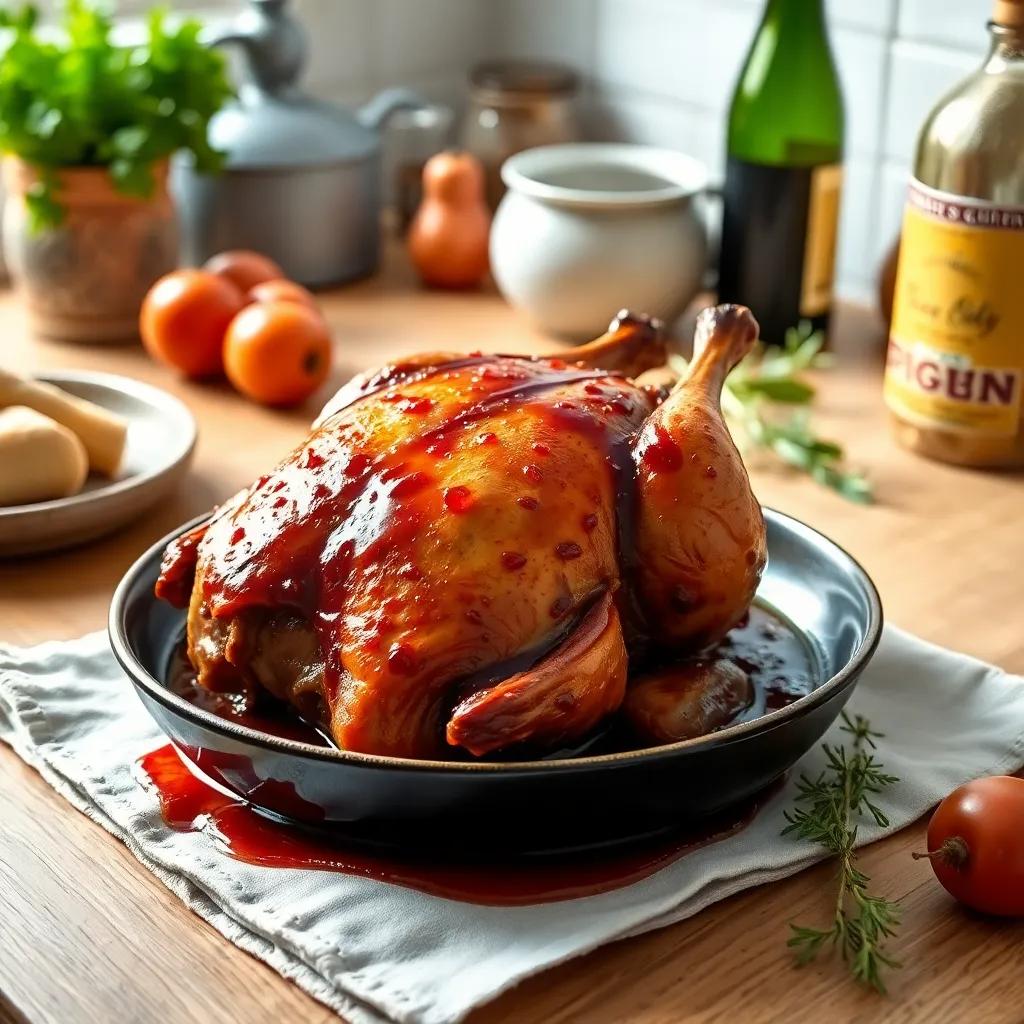
Leftovers & Storage
Leftover Coq au Vin is a treasure worth preserving—its flavors often deepen and mellow after a night in the fridge, making the next day’s meal just as delightful, if not more so. To keep your leftover portions safe and delicious, transfer the stew into airtight containers as soon as it cools to room temperature. Glass containers with tight-fitting lids or BPA-free plastic containers are ideal, as they prevent moisture loss and avoid odor absorption. Alternatively, heavy-duty freezer bags can work well if you plan to freeze the dish.
In the refrigerator, Coq au Vin will stay fresh for up to 3 to 4 days. For best results, store the meat and sauce together since the gradual blending of their flavors is part of the magic of this dish. When reheating, do so gently over low heat on the stove or in the microwave, stirring occasionally to maintain saucy richness and prevent drying out. A splash of chicken broth or a bit of wine added during reheating can help rejuvenate the sauce’s velvety texture.
If you want to enjoy Coq au Vin beyond a few days, it freezes beautifully. Divide the stew into meal-sized portions and freeze for up to 3 months. Make sure to cool it completely before sealing and freezing to minimize condensation and ice crystals, which can affect texture. When thawing, place the container in the refrigerator overnight and reheat slowly to coax back its full, luscious depth. Avoid refreezing leftovers once thawed to maintain quality and food safety.
Because Coq au Vin is a complete, hearty meal on its own, it works wonderfully as a make-ahead dish for busy weeknights or batch cooking for entertaining. Pack individual portions in microwave-safe containers for easy lunches or dinners that can be quickly warmed. If you’re bringing Coq au Vin to a potluck, transport it in a slow cooker or insulated container to keep it warm and ready to serve.
By following these storage tips, you ensure that every spoonful of your lovingly prepared Coq au Vin remains rich, tender, and deeply comforting—long after the initial cooking pot has been cleared from the table.
Behind the Recipe
Coq au Vin is a dish steeped in history and tradition, its roots tracing back to the rustic kitchens of rural France. Originally, this hearty stew was a practical solution for slow-cooking tougher roosters (“coq” means rooster) that needed extended time to become tender. The long simmer in wine not only softened the meat but also infused it with deep, complex flavors, turning humble ingredients into a celebratory meal. Over time, it evolved from peasant fare into a beloved classic that showcases the rich culinary heritage of Burgundy and other French wine regions.
For many, Coq au Vin evokes a sense of nostalgia and warmth—meals shared around the family table, lingering over conversation and good wine. Its methodical slow-cooking epitomizes the French respect for patience and technique in the kitchen. Each step—browning the chicken, rendering the bacon, building the sauce—is part of an unhurried ritual that transforms everyday ingredients into a dish brimming with soul.
On a personal note, this recipe often carries stories of gatherings and comfort. Whether marking a festive holiday or simply seeking solace on a chilly evening, Coq au Vin invites cooks to slow down and connect with food that nourishes both body and spirit. The satisfying aroma that envelops the home during its long simmer signals more than a meal—it promises a shared experience, a timeless glimpse into France’s culinary heart.
In essence, making Coq au Vin is as much about honoring tradition as it is about creating a feast that comforts and delights. This recipe, while approachable, is a doorway into a rich cultural legacy that continues to inspire home cooks worldwide to celebrate slow cooking, quality ingredients, and the joy of gathering around a savory, lovingly prepared table.
FAQ
Can I use a different type of wine if I don’t have red Burgundy?
Is it okay to use chicken thighs instead of a whole chicken?
Can I prepare Coq au Vin ahead of time and freeze leftovers?
How can I make this dish gluten-free?
Can I replace the bacon or lardons with something vegetarian?
What’s the best way to store leftovers to maintain flavor and texture?
Enjoy Your Meal!
There’s something timeless about a classic Coq au Vin — its rich, savory flavors wrapped in a warm hug of French comfort food. This recipe invites you to slow down, savor the moments, and bring a bit of rustic elegance to your own kitchen. Whether you’re cooking for family, friends, or simply yourself, it’s a dish that promises both satisfaction and a touch of culinary tradition.
If you give this Coq au Vin a try, I’d love to hear how it turns out! Feel free to leave a comment, share your favorite variations, or rate the recipe below. Happy cooking, and bon appétit!

